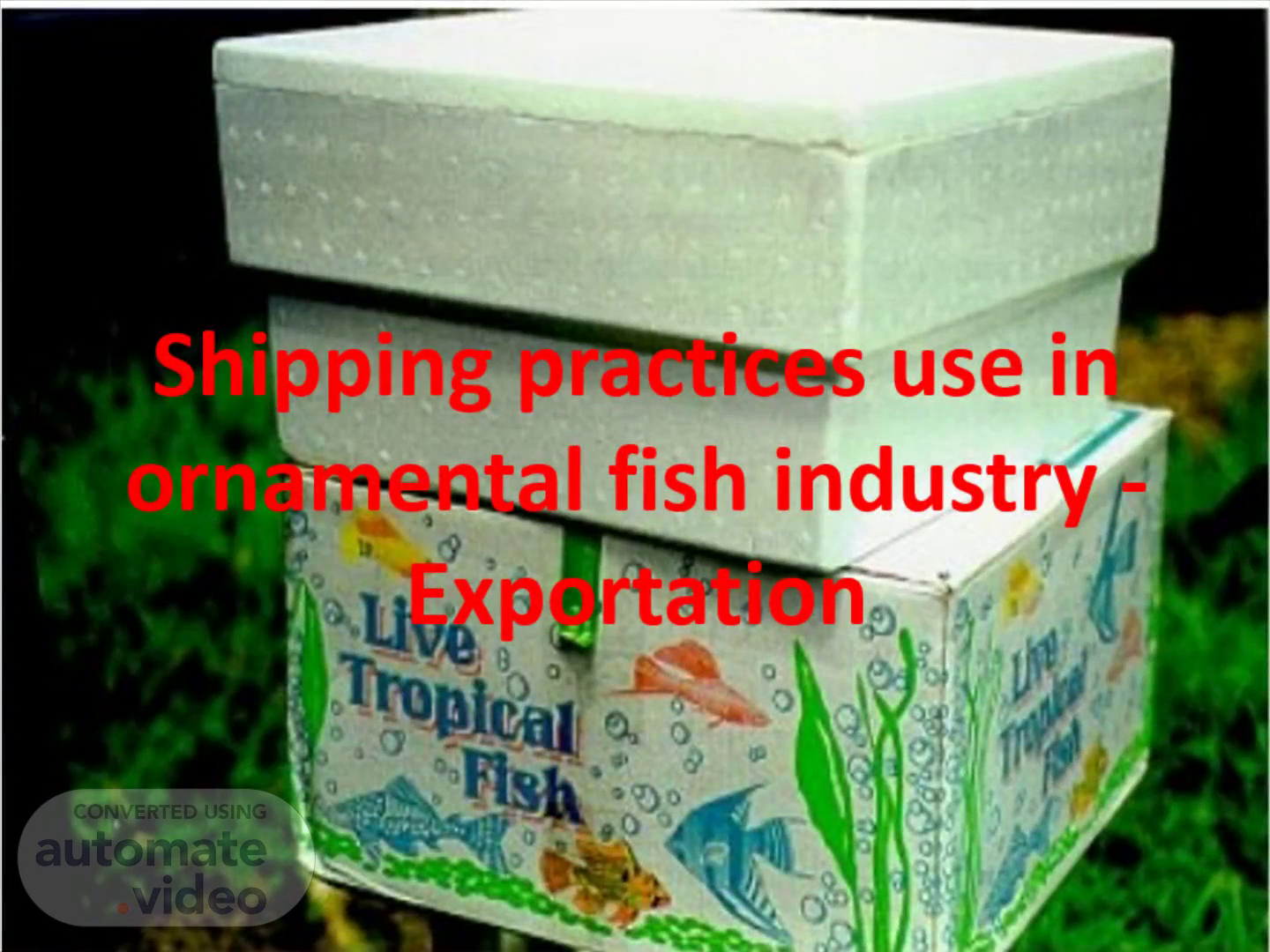
Shipping practices use in ornamental fish industry - Exportation
Scene 1 (0s)
Shipping practices use in ornamental fish industry - Exportation.
Scene 2 (18s)
Sri Lanka export ornamental fish for over than 30 countries including Japan, America, United Kingdom and other European Community countries. For success of ornamental fish industry, they have to export quality products. Therefore they followed different shipping practices. Some problems are faced by the fish during transportation process. Some of them are, Accumulation of CO2 Oxygen depletion Elevation of ammonia concentration due to metabolic activity..
Scene 3 (54s)
Densely packed shipping container can increase above mentioned problems. But this is a low cost transportation method. The dilemma of shopping is a cost effective and low risk mortality method..
Scene 4 (1m 37s)
Shipping Practices. In present most commonly used shipping methods are a variation on a single theme. Fish are packed in plastic bags and they are inflated with pure oxygen. It closed with rubber bands, placed in an insulated box and finally sealed. There are bags and boxes in various shape, size and insulation..
Scene 5 (2m 6s)
Square bottom bags Most of domestic farmers use square bottom bags These bags can utilize the surface area of the box more efficiently..
Scene 6 (2m 22s)
2 . Pleated Bags Pleated bags have flat bottom and these are highly recommended. Pleated bags can utilize the entire surface area of the box. Also it allows maximum oxygen transfer through the surface area of the water. If you can properly place this bag in the box, you can reduce fish crowding in the corners..
Scene 7 (2m 54s)
3. Pillow bags Usually in Asia use pillow bags for fish packing. These are made up of stock tube plastic and heat sealed at one end. When they are inflated there is no flat surface and packing water surface is increased by shipping these bags on their side. The manufacturing cost is low for pillow bags. Therefore these bags are widely used. Large bags (35 cm x 65 cm) are used for packing large number of small fish. 200 – 500 fish packed with smaller shipping bags. These large bags generally contain 5- 7 L of water and water to oxygen ratio is 35% : 65% or 20% : 80%..
Scene 8 (3m 19s)
Boxes Many various kinds of styles and types of boxes are used in the ornamental industry. Some boxes have loose panels, they used to line the box walls. It helps to keep required storage space to a minimum. Other boxes have stacking molded styrofoam compartments to use under extreme conditions. Normally boxes are packed in bag sizes of full to quarter. Full bags are utilized the entire box. The half bags are packed two to a box and quarter bags are packed four to a box. Full bag – 37.5 cm x37.5 cm x 55 cm.
Scene 9 (4m 3s)
Half bag – 40cm x 20cm x 55 cm Quarter bag – 40 cm x 10 cm x 55 cm.
Scene 10 (4m 47s)
Packaging procedures. Before fish harvesting and packing, there should be required materials. So there should be adequate room in holding tanks. To house the harvested fish and extra tanks for sorting by size or sex The chemicals are needed for pond treatment of parasites. Additives are needed for packaging..
Scene 11 (5m 9s)
Clean and well-lit area . A comfortable sorting table. Suitable bags for packaging Insulated styroform inserts and outer boxes. Full oxygen cylinders. Regulators to inflate the bags. Rubber bands to seal the bags. Tape to seal the bags. But any of above steps are missing, packing should not be completed..
Scene 12 (5m 44s)
Fish Packaging Steps and Procedures. 01. Preharvest- Preharvest fish should be examined for parasites and diseases. At least prior to harvesting. 02. Harvest Pond- Postharvest fish brought into holding tanks for sorting and sale. Fish should be checked again for parasites, diseases. 03. Sub treatment and purging- Feeding should be withheld for a minimum of two days up to five days depending on species. 04. Sorting and counting- Now fish are sorted and counted into bag lot quantities and held in individual aquaria, trays or buckets. 05. Final Packaging and addition of shipping additives- Any shipping additives can place into the bag at this time..
Scene 14 (6m 11s)
How to Pack Live Fish for Commercial shipment.
Scene 15 (6m 16s)
Shipping Additives. These are used to reduce stress and increase survivability. There are three categories. 1. Sedatives- Reduce the metabolic rate of fish, prevent injury from jumping or swimming into the sides of the box. Eg:quinaldine925 ppm), Tricane methane sulfonate 2. Water quality stabilizers- pH buffers, activated carbon, NaCl, Ice 3. Antibiotics- Caution should be used in the application of antibiotics. Tetracycline is the most widely used antibiotics for shipping and treatment for fish..
Scene 16 (6m 28s)
Receiving Fish. Most farm this ship will be receiving fish, either to resell or to add to their broodstock line. A quick assessment of the condition of the arriving fish can limit losses in such cases. They have to consider about temperature and pH differences between shipping bag water and receiving water. Enough CO2 is needed in this time. Normally when a bag of fish reaches its final destination it has been in transit for 24 to 48 hours. Un-ionized salt can added to reduce the stress..
Scene 17 (7m 0s)
Thank You.